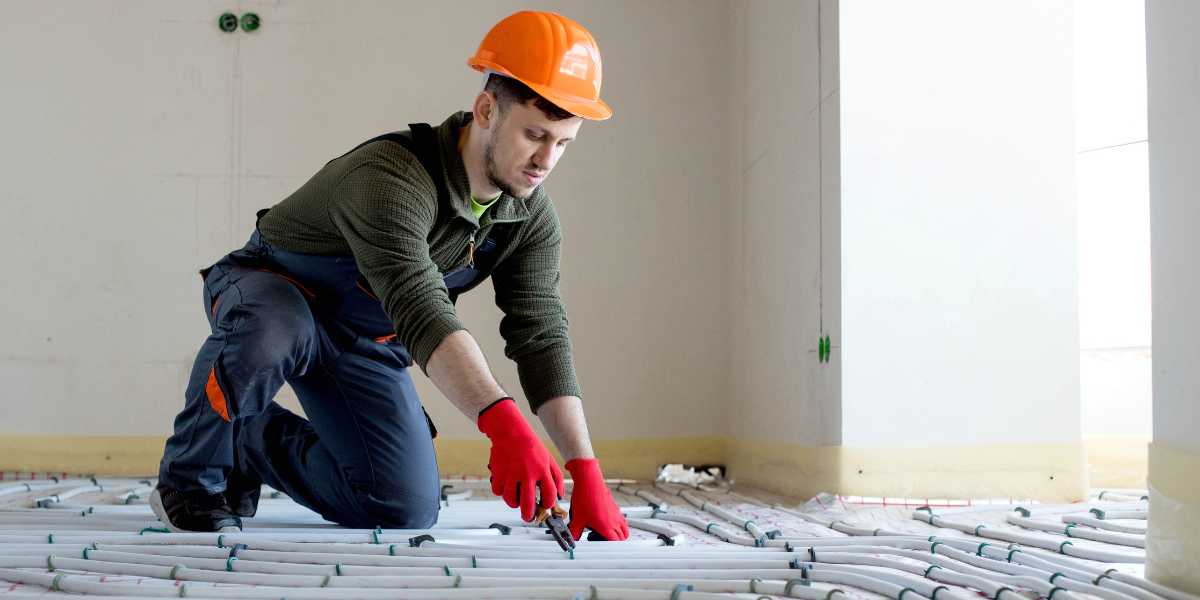Curious about radiant floor heating? Discover what radiant floor heating is, how it works, and its benefits for efficient, comfortable home heating.
Radiant floor heating is a type of heating system that warms your home through heat emitted from the floors. Unlike traditional heating methods, which rely on forced air or baseboard heaters, radiant heating is installed under the floor surface, providing even warmth that radiates upward.
This setup offers several benefits, including increased energy efficiency, even temperature distribution, and improved indoor air quality. In this guide, we’ll explore how radiant floor heating works, its main types, the installation process, and its pros and cons to help you understand if this heating system is right for you.
1. How Does Radiant Floor Heating Work?
Radiant floor heating works by transferring heat from panels or tubes beneath the flooring to the living space above. As the floor warms, it radiates heat upward, warming the entire room. This differs from traditional systems that rely on forced air, which can lead to uneven heating and drafts. Radiant heating creates a consistent, gentle heat that feels natural and reduces the need for high-temperature settings.
The heating method works through two primary systems:
- Hydronic (Water-Based) Radiant Heating: This system uses hot water that flows through a network of tubes under the floor. The water is heated by a boiler, and the heat radiates upward through the flooring. Hydronic systems are known for their efficiency and are commonly used in larger spaces.
- Electric Radiant Heating: This system uses electric heating cables or mats under the floor. When turned on, the electrical current heats the cables, which, in turn, heat the floor. Electric systems are simpler to install but are generally more suitable for smaller areas or where only supplemental heating is needed.
2. Types of Radiant Floor Heating Systems
There are three main types of radiant floor heating systems, which vary in their installation methods and heat delivery:
- Air-Heated Radiant Floors: These systems use heated air circulated through pipes or ducts embedded in the floor. Air-heated radiant floors are not commonly used because air does not retain heat effectively, making it less energy-efficient for most residential applications.
- Hydronic Radiant Floors: This is the most popular and energy-efficient form of radiant floor heating. A boiler heats water, which is pumped through a system of tubes installed under the flooring. Hydronic systems are ideal for whole-home heating and are particularly effective in larger spaces or homes with high heating demands.
- Electric Radiant Floors: This type of radiant heating uses electric heating cables or mats laid under the floor. Electric systems are often easier to install than hydronic systems and are a popular choice for small rooms like bathrooms, where supplemental heating can add comfort. However, they can be more costly to operate for larger spaces due to electricity costs.
3. Installation Process of Radiant Floor Heating
Installing radiant floor heating varies depending on the type of system chosen, the floor type, and whether the installation is new construction or a retrofit. Here’s a general outline of the installation process:
Electric Radiant Floor Heating Installation
- Preparation: The floor area is cleared and prepped. If this is a retrofit, existing flooring may need to be removed.
- Laying Heating Mats or Cables: Electric heating mats or cables are arranged according to the room layout, with consideration given to furniture placement and traffic areas.
- Covering with Thin-Set or Self-Leveling Compound: A layer of thin-set mortar or self-leveling compound is applied over the heating elements to encase them securely.
- Final Flooring: Once the heating elements are in place and covered, the final flooring material (like tile or laminate) is installed on top.
Hydronic Radiant Floor Heating Installation
- Designing the System: The system is designed with tubing layouts optimized for even heating. Tubes are placed with consistent spacing to ensure uniform warmth across the floor.
- Installing Tubing: PEX (cross-linked polyethylene) tubing is laid in a pattern (typically a serpentine or spiral pattern) and connected to a central manifold. The tubing is then embedded in a concrete or gypsum layer, depending on the subfloor material.
- Connecting to the Boiler: The tubes are connected to a boiler or other hot water source, which will heat the water that flows through the tubing.
- Pressure Testing: Before finalizing the installation, the system is pressure-tested to ensure there are no leaks.
- Flooring Installation: After testing, the chosen flooring material is installed over the system.
4. Suitable Flooring for Radiant Heating Systems
The type of flooring you choose can significantly impact the efficiency of a radiant heating system. Some flooring materials are better at conducting heat than others, which can enhance or reduce the effectiveness of the system.
- Tile and Stone: Tile and stone are highly conductive materials, which means they transfer heat efficiently. They also retain heat well, making them ideal for radiant floor heating, especially in bathrooms and kitchens.
- Laminate and Engineered Wood: Laminate and engineered wood floors can be compatible with radiant heating, as they conduct heat reasonably well and expand and contract less than solid wood. However, you should verify the product’s compatibility with radiant heating before installation.
- Carpet: Carpeted floors are generally not ideal for radiant heating because they insulate against heat transfer, reducing efficiency. Low-pile carpets with dense padding may work, but this setup typically results in slower heating.
- Vinyl and Linoleum: Some vinyl and linoleum floors are compatible with radiant heating, but it’s essential to check the manufacturer’s guidelines to ensure the material can withstand heat without damage.
5. Advantages of Radiant Floor Heating
Radiant floor heating offers a range of benefits, making it an attractive option for homeowners seeking an efficient and comfortable heating solution.
- Energy Efficiency: Radiant heating systems are more energy-efficient than forced-air systems, often operating at lower temperatures while delivering consistent warmth. Hydronic systems, in particular, are known for their cost-effectiveness.
- Comfort: Radiant heat eliminates drafts and provides even, gentle warmth throughout the room. The heat radiates up from the floor, creating a cozy, naturally comfortable environment.
- Better Air Quality: Since radiant heating doesn’t rely on forced air, it doesn’t circulate dust, allergens, or pollutants. This feature can be especially beneficial for individuals with allergies or respiratory issues.
- Quiet Operation: Unlike forced-air systems that create noise through ducts and blowers, radiant floor heating is silent. Once installed, it operates quietly and consistently without the background noise typical of many traditional heating systems.
- Increased Floor Space: Radiant heating systems are hidden beneath the floor, freeing up wall and floor space for furniture and decor.
6. Potential Drawbacks of Radiant Floor Heating
While radiant floor heating offers many advantages, it’s important to consider the potential downsides:
- Higher Installation Costs: Radiant heating systems can be more expensive to install than traditional heating options, especially if it requires retrofitting.
- Slow Heating Response: Radiant heating systems typically take longer to reach the desired temperature because they warm the floor first, which then radiates upward. This is less of an issue with hydronic systems, as they can retain heat for extended periods.
- Flooring Limitations: Not all flooring materials are compatible with radiant heating, which may limit your options. Thick carpets or certain types of hardwood can hinder heat transfer and reduce system efficiency.
- Electricity Costs: Electric radiant floor heating can be costly to run in larger spaces, making it more suitable for smaller rooms where supplementary heating is needed.
7. Maintenance and Longevity
One of the appealing aspects of radiant floor heating is its low maintenance requirement. Once installed, these systems generally have fewer moving parts and require less upkeep than forced-air systems. However, there are a few things to keep in mind:
- Hydronic Systems: These systems require occasional inspections to ensure the boiler, pumps, and pipes are functioning correctly. Proper maintenance of the boiler is essential for system longevity.
- Electric Systems: Electric radiant heating typically requires minimal maintenance. However, if there’s an issue with the heating elements, repairs may involve lifting sections of the flooring.
- Longevity: When properly maintained, hydronic systems can last upwards of 35 years, while electric systems can last around 20 years.
8. Is Radiant Floor Heating Right for You?
Radiant floor heating may be a great choice if you’re looking for efficient, comfortable, and quiet heating. It’s particularly well-suited for homes in cooler climates or for homeowners who prioritize energy efficiency and improved indoor air quality. However, it’s essential to consider the higher initial installation cost, compatibility with your flooring, and heating needs.
Radiant floor heating is an innovative and efficient way to heat your home by delivering warmth directly from the floor up. Offering benefits like energy efficiency, improved comfort, and enhanced air quality, this system provides a quiet and clean alternative to traditional heating method.
While the initial cost of installation can be high, the long-term energy savings and comfort make radiant heating an appealing option for many homeowners. If you’re considering this type of heating system, consulting with a heating professional can help you assess the feasibility and benefits specific to your home.


